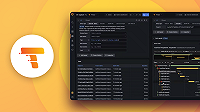Important: This documentation is about an older version. It's relevant only to the release noted, many of the features and functions have been updated or replaced. Please view the current version.
Example setups
You can use Grafana Cloud to avoid installing, maintaining, and scaling your own instance of Grafana Tempo. Create a free account to get started, which includes free forever access to 10k metrics, 50GB logs, 50GB traces, 500VUh k6 testing & more.
The following examples show various deployment and configuration options using trace generators so you can get started experimenting with Tempo without an existing application.
For more information about Tempo setup and configuration, see:
If you are interested in instrumentation, see Tempo instrumentation.
Docker Compose
The docker-compose examples are simpler and designed to show minimal configuration.
Some of the examples include:
- Trace discovery with Loki
- Basic Grafana Agent/OpenTelemetry Setup
- Various Backends (S3/GCS/Azure)
- K6 with Traces This is a great place to get started with Tempo and learn about various trace discovery flows.
Helm
The Helm example shows a complete microservice based deployment. There are monolithic mode and microservices examples.
To install Tempo on Kubernetes, use the Deploy on Kubernetes using Helm procedure.
Tanka
To view an example of a complete microservice-based deployment, this Jsonnet based example shows a complete microservice based deployment. There are monolithic mode and microservices examples.
To learn how to set up a Tempo cluster, see Deploy on Kubernetes with Tanka.
Introduction to Metrics, Logs and Traces example
The Introduction to Metrics, Logs and Traces in Grafana provides a self-contained environment for learning about Mimir, Loki, Tempo, and Grafana. It includes detailed explanations of each compononent, annotated configurations for each component.
The README.md file has full details on how to quickly download and start the environment. Additionally, you can use the ctl.sh script to alter the environment to send metrics, logs, and traces to Grafana Cloud.


